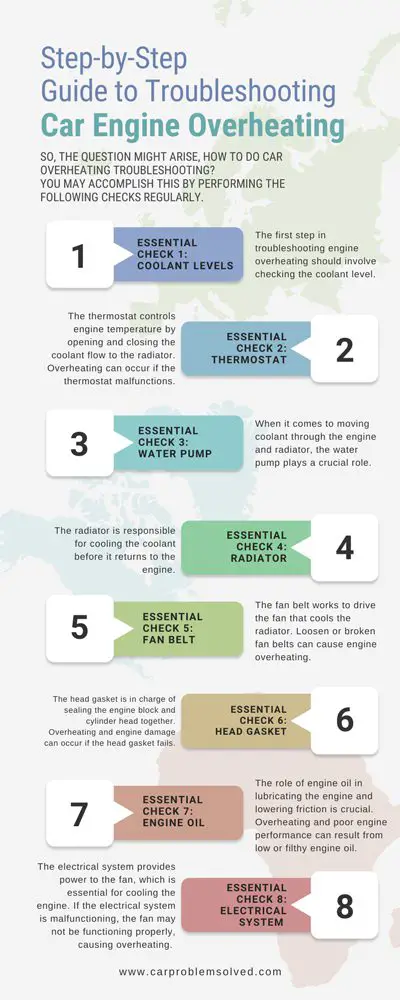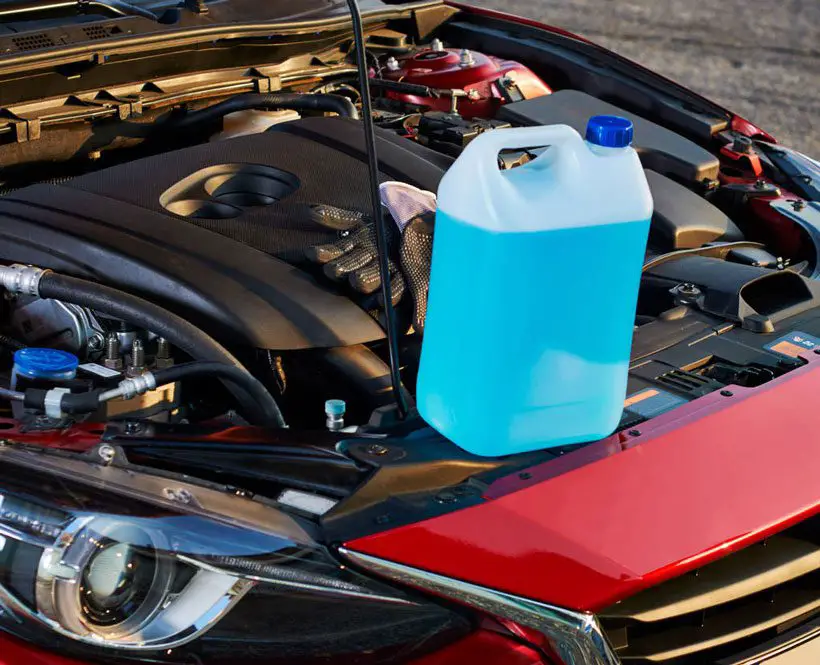Car engine overheating is a common issue that many drivers face. It can be caused by a variety of problems, ranging from a simple low coolant level to a malfunctioning water pump or a blown head gasket. Thus, overheating can cause engine damage, reduced performance, and even engine failure.
So, car overheating troubleshooting, what does it include? This troubleshooting may include some basic checks on the cooling system, thermostat, radiator, water pump, and other components.

In this guide, we will provide a comprehensive guide to troubleshooting car engine overheating problems. We will explain the common causes of overheating and provide step-by-step guidance on identifying and fixing common engine overheating issues. We will also offer tips for preventive maintenance to avoid overheating problems in the future.
Car Overheating: Step-by-Step Guide to Troubleshooting Car Engine Overheating

So, the question might arise, how to do car overheating troubleshooting?
You may accomplish this by performing the following checks regularly.
- Checking Coolant Levels
- Inspecting the Thermostat
- Inspecting the Water Pump
- Checking the Radiator
- Inspecting the Fan Belt
- Checking the Head Gasket
- Checking the Engine Oil
- Inspecting the Electrical System
These are some common troubleshooting techniques you may use to rescue your automobile from overheating. You may encounter extra activities if you believe they are appropriate for your vehicle.
Nonetheless, we will now go through all of the troubleshooting steps in detail. Well, let’s get this ball rolling!
Essential Check 1: Coolant Levels
The first step in troubleshooting engine overheating should involve checking the coolant level. Low coolant levels can cause overheating, as coolant regulates engine temperature.

To check the coolant level,
- Wait for the engine to cool down
- Open the radiator cap or overflow tank. The coolant level should be between the minimum and maximum marks
- If the level is less than regular, add coolant until it reaches the proper level
Essential Check 2: Thermostat
The thermostat controls engine temperature by opening and closing the coolant flow to the radiator. Overheating can occur if the thermostat malfunctions.

To inspect whether or not it’s a malfunctioning thermostat, perform the following steps:
- Start the engine
- Let it run until it reaches operating temperature
- Use a thermometer to measure the temperature of the coolant at the radiator hose inlet and outlet
- If there is a significant temperature difference, the thermostat may malfunction
- Replace the thermostat
Essential Check 3: Water Pump
When it comes to moving coolant through the engine and radiator, the water pump plays a crucial role. However, if the water pump is not functioning properly, it can lead to inadequate coolant circulation and result in overheating.
Perform the following activities to inspect your car water pump:
- Open the hood and locate the water pump near the front of the engine, connected to the fan belt
- Check for leaks, damage, or corrosion around the pump
- Wiggle the water pump pulley back and forth to check for any movement or play, indicating a worn or damaged bearing
- Inspect the impeller blades responsible for circulating coolant. If they are worn or damaged, it may cause engine overheating
- If the water pump seems to be bad, have a professional mechanic inspect and repair the water pump to avoid further damage to your engine.
Essential Check 4: Radiator
The radiator is responsible for cooling the coolant before it returns to the engine. If the radiator is clogged or damaged, it can cause overheating. To check the radiator, go through the following steps:

- Make sure your car engine is cool before inspecting the radiator
- Locate the radiator under the hood, usually near the front of the engine
- Check the radiator cap for any signs of damage or corrosion
- Inspect the radiator fins for any visible damage, such as bends or cracks
- Check the coolant surface in the radiator by looking at the overflow tank or by removing the radiator cap. If the coolant surface is low, add the recommended type of coolant to the radiator until it reaches the appropriate level
- Start the car engine and let it run for a few minutes. Observe the temperature gauge and make sure it does not indicate overheating
- While the engine is running, visually inspect the radiator for any leaks or signs of damage
- Check the radiator hoses for any signs of wear, cracks, or leaks
Essential Check 5: Fan Belt
The fan belt works to drive the fan that cools the radiator. Loosen or broken fan belts can cause engine overheating.
To inspect the fan belt, go through the following activities.
- Locate the fan belt under the hood. It’s connected to the alternator, water pump, and other engine components
- Visually check the fan belt for cracks, fraying, or glazing. If any of these signs are visible, replace the fan belt
- Check the tension of the fan belt by pushing on it with your fingers. In most cases, it can move down half an inch
- If it feels loose, tighten or replace it
- Listen for any unusual sounds produced by the engine or the fan belt. If you hear any, inspect the fan belt more closely and replace it if necessary

Essential Check 6: Head Gasket
The head gasket is in charge of sealing the engine block and cylinder head together. Overheating and engine damage can occur if the head gasket fails.
To check the head gasket,
- Locate the head gasket between the engine block and cylinder head
- Inspect the oil dipstick for milky or bubbly oil, which could indicate a blown head gasket
- Check the coolant for oil or bubbles by removing the radiator cap
- Use a block tester to test the coolant for exhaust gases
- If needed, remove the cylinder head to inspect the head gasket for damage or leaks
If the head gasket is blown, it needs to be replaced.
Essential Check 7: Engine Oil
The role of engine oil in lubricating the engine and lowering friction is crucial. Overheating and poor engine performance can result from low or filthy engine oil.

To check the engine oil,
- Locate the oil dipstick under the hood
- Pull out the dipstick and wipe it clean with a cloth
- Re-insert the dipstick fully into its tube
- Pull out the dipstick again and check the oil level
- Check the oil color and consistency
- If the oil level seems lower, add more oil
If the oil is dark, gritty, or has a burnt smell, it may be time for an oil change.
Essential Check 8: Electrical System
The electrical system provides power to the fan, which is essential for cooling the engine. If the electrical system is malfunctioning, the fan may not be functioning properly, causing overheating.
To inspect the electrical system,
- Check the fan fuse and relay to ensure they are not blown or damaged
- You can also use a multimeter to test the voltage at the fan connector when the engine is running
If there is no voltage, the problem may be with the fan switch or the wiring, and it needs to be repaired or replaced.
Preventive Maintenance Tips for Avoiding Car Engine Overheating
There are a few preventative measures you can take to prevent your car from overheating. They include

Coolant System Checks
- Regularly check the coolant system for leaks, damaged hoses, and other issues.
- You can also flush the coolant system every 2-3 years to remove any buildup and ensure proper coolant flow.
- Additionally, ensure that the coolant mix is correct, as an incorrect mix can cause overheating.
Monitoring Temperature Gauge
- Monitor the temperature gauge on the dashboard regularly to ensure that the engine is not overheating.
- If the gauge shows a higher-than-normal temperature, pull over immediately and check the engine for any issues.

Regular Maintenance
- Regular maintenance is essential for preventing car engine overheating problems.
- It includes changing the oil and filter regularly, replacing worn belts and hoses, and checking the coolant level and quality.
- Regular maintenance helps identify any potential issues before they become major problems and avoids engine overheating.
Conclusion
Car overheating troubleshooting is an essential part of car maintenance to ensure optimal performance and prevent costly engine damage. By regularly checking coolant levels, thermostats, water pumps, radiators, fan belts, and head gaskets, owners can diagnose and fix overheating issues.
We have also highlighted preventive maintenance tips to avoid overheating problems in the future. These include
- Coolant level inspection along with regular maintenance
- Finally, don’t hesitate to seek professional help if you notice any issues during the inspection.
- Or if you are unsure about performing any of the checks yourself, you should consult with an expert
